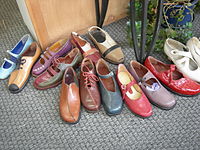Locomotor effects of shoes

When we walk or run, our feet touch the ground and our brains tell our muscles how to move us forward. But when we wear shoes, it can change the signals our brains receive and affect how we move.
Some shoes have thick and cushioned soles that absorb the shock of each step we take. This can make it more comfortable to walk, but it also means that our feet don't feel the ground as much. As a result, our brains may not receive the same level of sensory feedback and may not know how much force to use when stepping down. This can make us less stable and increase the risk of falls or injuries.
On the other hand, shoes with thin and flat soles allow our feet to feel the ground more. This can help our brains receive better sensory feedback and adjust our movements accordingly. We may become more stable and efficient in our movements, but it can also make walking or running on hard surfaces more uncomfortable.
Additionally, the design of the shoe itself can impact how we move. Shoes with a lot of cushioning may encourage us to take longer strides, while shoes with a more minimalist design may encourage shorter and quicker steps.
In summary, the shoes we wear can affect how our brains receive feedback and how we move. Thick and cushioned soles may make us more comfortable but less stable, while thin and flat soles may improve our stability but also cause discomfort on hard surfaces. The design of the shoe may also impact our overall movement patterns.
Some shoes have thick and cushioned soles that absorb the shock of each step we take. This can make it more comfortable to walk, but it also means that our feet don't feel the ground as much. As a result, our brains may not receive the same level of sensory feedback and may not know how much force to use when stepping down. This can make us less stable and increase the risk of falls or injuries.
On the other hand, shoes with thin and flat soles allow our feet to feel the ground more. This can help our brains receive better sensory feedback and adjust our movements accordingly. We may become more stable and efficient in our movements, but it can also make walking or running on hard surfaces more uncomfortable.
Additionally, the design of the shoe itself can impact how we move. Shoes with a lot of cushioning may encourage us to take longer strides, while shoes with a more minimalist design may encourage shorter and quicker steps.
In summary, the shoes we wear can affect how our brains receive feedback and how we move. Thick and cushioned soles may make us more comfortable but less stable, while thin and flat soles may improve our stability but also cause discomfort on hard surfaces. The design of the shoe may also impact our overall movement patterns.
Related topics others have asked about:
